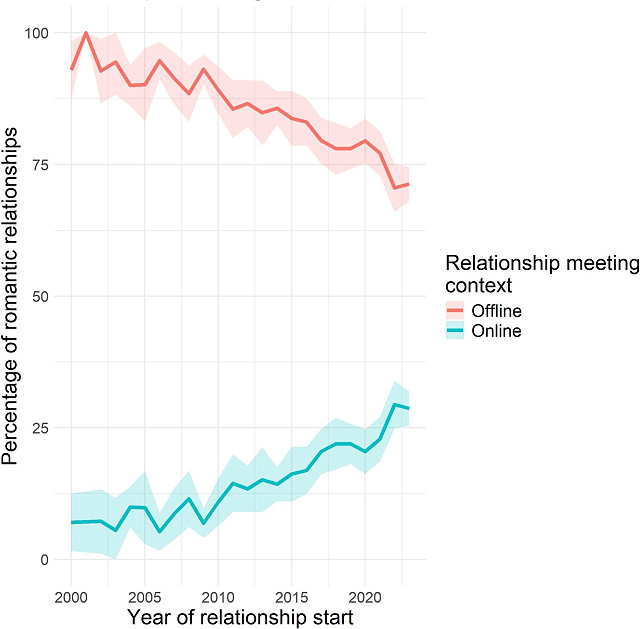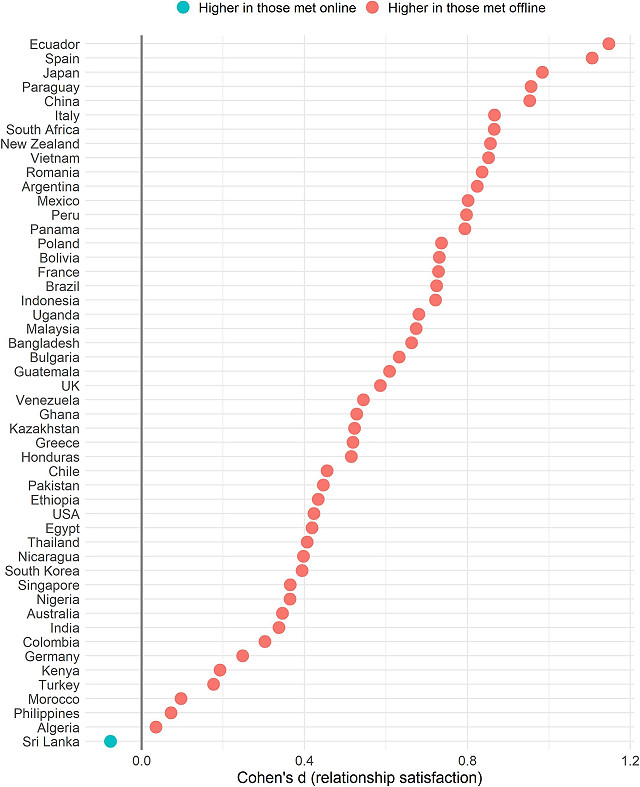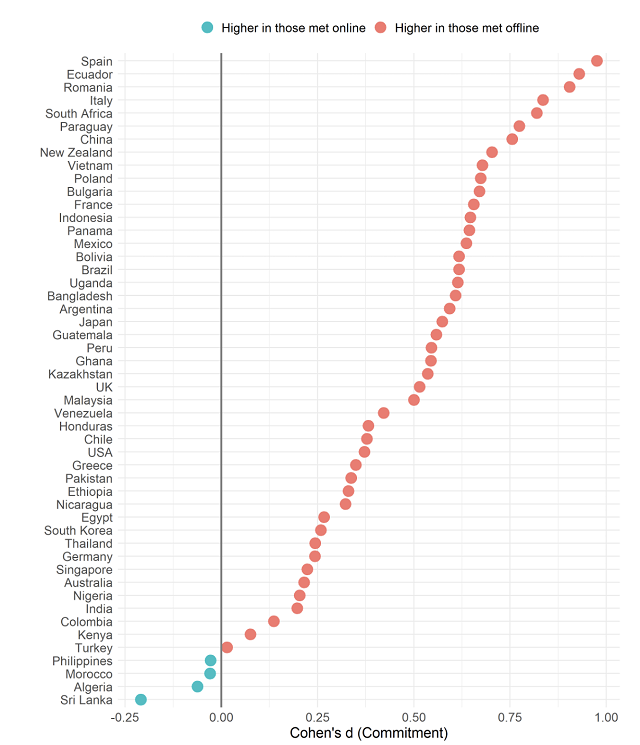Highlights
- A new global study finds that 16% of participants across all countries met their partners online, ranging from a high of 33% in Poland to a low of 8% in Ghana. Post This
- Perhaps meeting online promotes a transactional approach to relationships that is not entirely compatible with relationship satisfaction and love. Post This
- On average, participants across all countries were more satisfied with their relationship and experienced greater intimacy, passion, and commitment if they had met their partners offline vs. online. Post This
There is a video clip that goes viral every once in a while showing how couples met in the U.S. and how that has changed over the decades. In 1930, for example, the most common way couples met was through family. By 1943, that had changed to meeting through friends, and this stayed that way until about 2012, when for the first time, the most common way couples met was online (through dating apps, social media, or the internet). By 2022, according to a study of young adults by the Institute for Family Studies, more than a third of adults younger than 35 met their partners online. Another study from 2019 shows that among American heterosexual couples, 39% met online. The dramatic rise of online dating has not just been an American phenomenon but is found across the world.
Given its popularity, one might think that meeting your partner online leads to better quality relationships and marriages. But does it? Previous research on this subject finds mixed results, with some researchers finding that meeting online leads to more marital satisfaction, some research finding no results, and other research finding that meeting online leads to less marital satisfaction. Most of these studies have been done in rich developed countries, such as the U.S., and very few in less developed countries.
Online Dating and Relationship Satisfaction
A new study by psychologists at the University of Wroclaw in Poland revisits the issue using data from 50 countries, including countries in North and South America, Europe, Africa, South Asia, and East Asia, for a total of 6,646 partnered individuals. They found that on average, 16% of participants across all countries had met their partners online, ranging from a high of 33% in Poland to a low of 8% in Ghana. As expected, this data also showed that the percentage of romantic relationships begun online has risen dramatically since 2000 across all countries, while the percentage of relationships begun offline has fallen (see figure below).
Figure 1: Relationship Context Over Time

Note: Figure shows the percentage of participants who met their romantic partners online or offline by the year their relationship was formed. Shadow areas show 95% confidence intervals.
The researchers examined how meeting online or offline influenced both relationship satisfaction and the intensity of experienced love in relationships. To do this, they used statistical models that controlled for the fact that the chance of online dating varies by country, with people in richer countries having a greater likelihood of meeting their partners online. Analyses were restricted to people whose relationship began after 2010. Relationship satisfaction was measured with the answer to the question: “How satisfied are you with your relationship with your partner?” Intensity of experienced love was measured using questions that assessed intimacy, passion, and commitment in the relationship.
On average, across all countries, participants were more satisfied with their relationship and experienced greater intimacy, passion, and commitment if they had met their partners offline than if they had met their partners online. These differences were small for relationship satisfaction, intimacy, and passion, and moderate for commitment (see the following figures).
Figure 2. Differences in Weighted Relationship Satisfaction

Note: Figure shows the differences in weighted relationship satisfaction between individuals who met their partners online vs. offline across countries.
Since factors such as participant sex, age, length of relationship, and socioeconomic status also influence relationship satisfaction and the experience of love, the researchers controlled for these factors. They found that even with these controls, couples who met online reported less relationship satisfaction and a lower intensity of experienced love than couples who met offline. Adjusting for the participant’s years of education, residential area (urban or rural), and sexual orientation also did not change this result.
It is possible that people who had met offline were more likely to break up and thus the sample overrepresented people who had met their partner offline and stayed together, and this selection bias may account for the result. Yet the researchers found that even after adjusting for possible selection bias, those who met their partner offline still had increased relationship satisfaction and higher levels of experienced love, all else being equal.
Figure 3. Differences in Weighted Commitment

Note: Figures shows the magnitude of differences in Commitment (weighted) between individuals who met their partners online vs. offline across countries.
Furthermore, people in urban and rural areas found partners online at about the same rates, and there was no evidence that younger people were more likely to find their partners online than older people. They also found no sex difference in chance of meeting a partner online.
Why Meeting in Real Life Is (Still) Best
The results of this new global study are similar to results reported at IFS for young Americans. Among married young adults, only 61% of those who met their spouse online said they were very happy, compared to 65% of people who met their spouse through friends, 73% of people who met their spouse at school, and 76% of people who met their spouse at church or other religious activities.
It seems that meeting in more traditional ways in real life leads to happier relationships and marriages than meeting online. Why would this be? Perhaps couples who meet online are less similar in terms of education, ethnicity, religion, and shared values and interests than couples who meet offline, as some previous research has suggested. This lack of similarity (or homogamy) may promote less satisfaction with the relationship and lower levels of experienced love. Or it may be that meeting online promotes a transactional approach to relationships that is not entirely compatible with relationship satisfaction and love. Regardless, despite the increasing popularity of online dating, its inability to deliver better relationships than traditional dating is an example of how the promise of new technology can ring hollow.
Rosemary L. Hopcroft is Professor Emerita of Sociology at the University of North Carolina at Charlotte. She is the author of Evolution and Gender: Why it matters for contemporary life (Routledge 2016), editor of The Oxford Handbook of Evolution, Biology, & Society (Oxford, 2018), and author (with Martin Fieder and Susanne Huber) of Not So Weird After All: The Changing Relationship Between Status and Fertility (Routledge, 2024).













